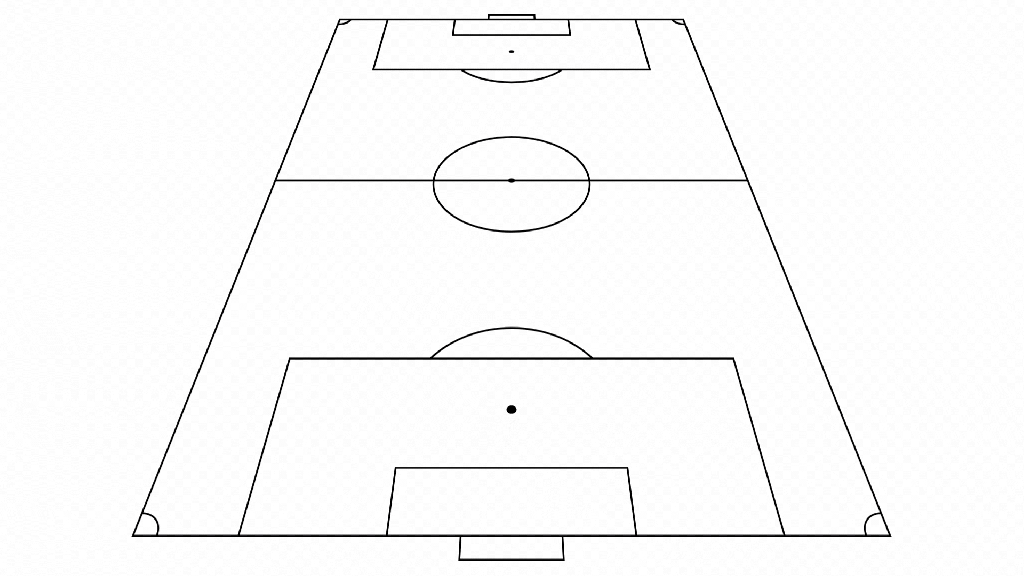
It’s ten to seven on a chilly July morning on the shores of Lake Macquarie in Australia’s Hunter Valley. The astroturf is frosty and the balls are already darting around in small rondos. The games move rapidly, A-League rising stars Archie Goodwin and Lucas Mauragis are on the pitch today.
It’s ten to seven on a chilly July evening under the flight path of Moorabbin Airport in South East Victoria. The grass is slick and the balls are already darting around in small rondos. The games move rapidly, A-League alumni Golgol Mebrahtu and Ben Carrigan are on the pitch tonight.
At both locations, equipment is dotted across the pitch. Rubber discs lay motionless and ready, marking out carefully measured areas of play. A set of meticulously positioned mannequins stand tall, ready to act as imaginary defenders. Nothing out of the ordinary, until the breeze catches the sound and delivers it to your ears. A large speaker placed alongside the pitch reverberates a familiar beat across the field of play. The clock is ticking.
At first glance, we understand football as a spatial contest. We look for shapes, patterns, spaces and players’ positioning in relation to these. We imagine territorial moves and countermoves. This is reinforced in the catalogue of advanced metrics now used to capture how effectively space is occupied and dominated. Yet, players exist within a continuum of events, orchestrated by the arrow of time. Time’s passage, though unyielding, presents a unique lens. A temporal structure. In order to truly relate and connect play, we must comprehend not only three dimensional space of width, depth and height but also the position of players within the fourth dimension, orientating their actions in relation to time’s flow. Football is a game of where but perhaps more importantly, when.
“If you do not relate to others, you do not know anything and you cannot do anything. There is the space-time thing to apprehend in this game. And if you are not aware of it and you’re not thinking about it, it’s complicated… What`s Football? It’s space-time…Losing time in football is like losing gold.” – Xavi Hernandez, FC Barcelona
Time can dilate and bend, even in football. The ball has a gravitational pull. When you are on it or near it, time feels faster. Spaces begin closing and danger is likely close by. Actions can become hurried, thinking rushed and decisions inconsistent. Yet, outside of the ball’s immediate vicinity, time feels like it runs more regularly. There is a way to lessen the impact of the ball-near zone’s effect on players’ perception of time and increase the harmony of team play. That is to use time as an underlying structure. A framework that can be both relational and positional.


“Art is how we decorate space. Music is how we decorate time.” – Jean Michel Basquiat
There is a strong connection between football, time and music. Without time musicians would have no dimension to play notes against. Football’s synchronisation relies not only on movement of player and ball but the rhythm that underpins it. The harmonious teamwork of the best football teams can mirror the composition and performance of music, coordinated by the most skilled composers.
Time cannot currently run backwards and we are always in the present, but memory gives us a perception of the past and imagination gives us a vision of the future. We experience the future in music through expectation. We can see or feel intuitively what is coming next and that is what makes the music coherent and pleasant to hear. Much like music engages time through expectation, football’s anticipation of teammates’ actions becomes pivotal.
“Into a section of mortal time music pours itself, thereby inexpressibly enhancing and ennobling what it fills.” – Thomas Mann
There are many different styles of music but it seems football is limited to a small, hotly-debated handful. This understanding of what makes us enjoy music can help us to synchronise team play and explore different micro-genres of football that can be enjoyed by varying audiences. Using musical timing as a base, the lines between different play styles can be blurred to create more variety, enrich the game and find new ways to choreograph and play.
Time’s impact on music is quantified as tempo. Tempo is typically measured in beats per minute (BPM) and governs the speed at which a piece of music is played, or how far apart the beats are spaced in a continuum. Tempo is the underlying temporal structure and without it, we would have no idea at what speed to play. Tempo is the canvas upon which rhythm is constructed and being able to maintain a steady tempo requires good timing. It determines the overall mood or feel. Tempo does not need to be static. Its timing can change dynamically within a piece to create contrasts, alter the mood and provoke a new reaction.
The beat is the evenly spaced underlying pulse which is modulated by the tempo. Tap, tap, tap. Touch, pass, touch, pass. This regular beat, also known as “meter” provides the structural predictability. It is familiar and we can guess what comes next which motivates us to move along in time with it. This causes our endogenous opioid system (EOS) to release chemicals for bonding, happiness and resilience in response to our synchronisation with the beat. This beat acts as a grid that we can lock back into if we get lost in a piece of music or passage of play.

In football, each beat can represent an attacking action. A touch, pass, dribble, shot or movement. The tempo and the beat are the substructure which the team’s play can snap back into. Formations provide a structure in space, the team tempo and beat give us a structure in time. This guides us to identify both where and when we should be in relation to the team and facilitates reorganisation after passages of chaos.

Musicians playing together in an ensemble can “jam” but the level of harmony this produces is heavily dependent on the skill of the players, the existing relationship between them and how well they recognise the piece of music being played. The worse these are, the sooner it becomes an incoherent, unpleasant cacophony. What produces true harmony is the substructure of tempo, beat, and rhythm. This produces cohesive playing and allows skilled musicians to venture off into moments of improvisation before returning to the underlying temporal structure. The tempo and beat keeps the players in sync and this can also work for a football team. Without this framework, we can understand where in space to be but we don’t always know when to be there and the timing of our play is inconsistent, resulting in the equivalent of a footballing cacophony. Noise without harmony. Tempo can be variable. Some songs have sections that are played faster or slower than others to generate appropriate feelings. Underlying tempo can change between phases of play but must be collectively understood.
If a formation is the spatial framework (how we reorganise in width and depth) then tempo and beat are the temporal framework (how we reorganise in time). Team tempo allows players to understand when to perform an action within 3D space, in sync with the team’s beat. Most importantly, it can give a clear reference point for the timing of movements while improving spatial occupation. Take the example of a team playing at 60BPM. Ideally, when Player A (the ball carrier) passes the ball on the beat, the ball should arrive to Player B (the receiver) on the next beat. This means that the ball shouldn’t take longer than one second to travel between Player A and B in order to maintain the team tempo. In order for this to happen, the spatial relationship between teammates needs to adjust to the correct distance thereby altering the spatial occupation and structure of the team to facilitate this. Distances between players governed by time.
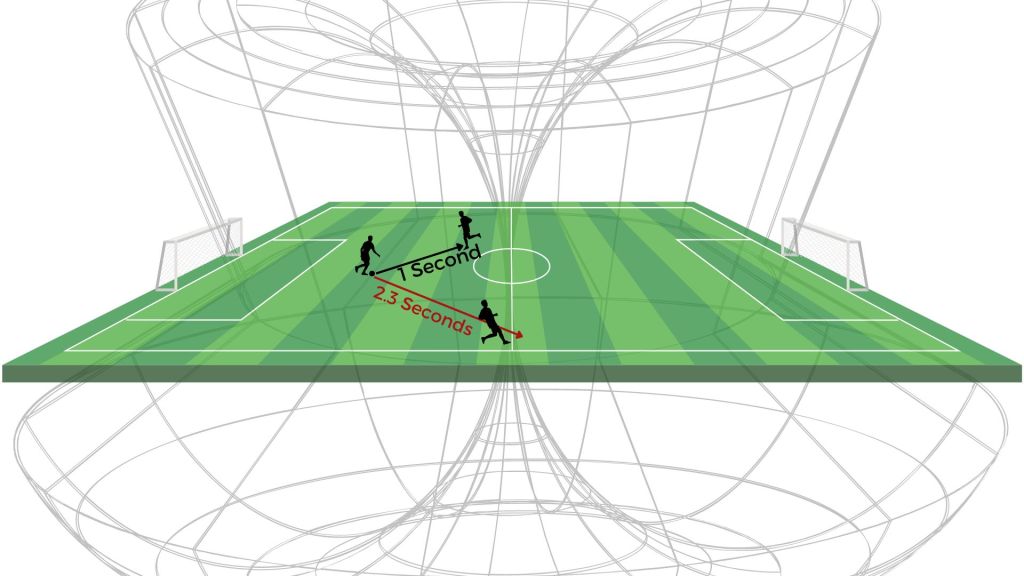
Football is not a linear game, though. A band which only plays a flat, monotonous beat would get tiresome pretty quickly. In the fluid situations presented by football, a team wouldn’t be able to solely rely or always be able to play at the same speed. If tempo is the structure, then rhythm is the flow built upon it. Rhythm is the pattern built into the space between the beats. It does not need to be evenly spaced and has the ability to vary. Those variations in the intervals of time are what bring it to life. As humans, we are familiar with two vital rhythms: heartbeat and breath. Both obey a steady tempo and beat but their rhythm can change depending on the scenario and conditions. Rhythm takes a solid, measurable phenomenon such as beats per minute (tempo) and turns it into adjustable, situational art using the fabric of time. It is literally how the beat alters and flows across time. In a sporting sense, if we see tempo and beat as a locked in structure, we can alter our rhythm in different moments or phases of play to speed up or slow down play as required, as long as the play snaps back to the temporal structure at times throughout a passage of play. In tight spaces or situations of close proximity, it may be required for the players to speed up the rhythm of play with an understanding that it will eventually return to the team tempo when space reopens or the situation alters.
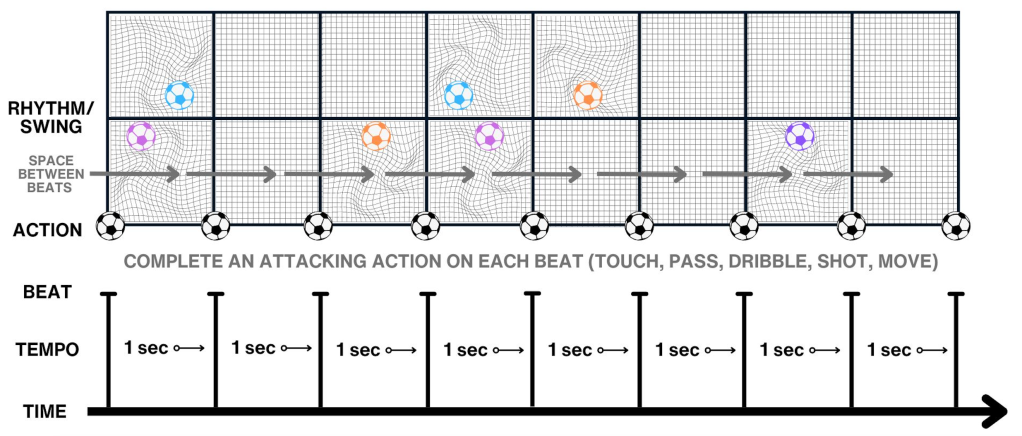
“The biggest thing in the build-up is the control of rhythm. If you look at Guardiola, he does it with the speed of the passes and then they carry the ball when they don’t have pressure. De Zerbi does it more with the moment of the pass, the lure, the sole on the ball, opening space with the pass rather than the carry. How you control the rhythm and progress through space will be big in the future. That development has already started.” – Rene Maric
De Zerbi’s Brighton are an example of rhythm being used as a tool for ball progression. They use pauses in their play to generate suspense and impatience. They provoke the opponent to gravitate toward the ball before moving it past them at a more regular tempo and exploiting the spaces that they have created. This is an example of using time to influence the spatial distribution of the opponent. It is expected that this method of build up will become a trend across other top teams as we’ve already seen with Manchester City’s approach to build up in the Community Shield.
“What has come into the Premier League just recently is the idea of the pause and Brighton are very good at it. Previously, everyone was trained to play fast, flowing football. They wait. In moments, the game is completely static. And then, they will accelerate to break the press.” – Chris Davies, Tottenham Assistant Coach
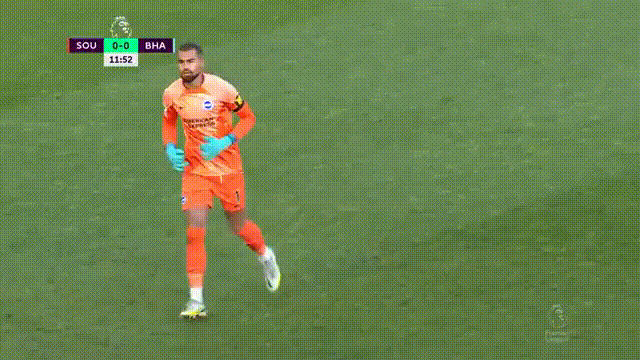
The temporal element of football has always existed on an individual level, but until only recently has there been a conscious and strategic collective attempt to exploit it. The team tempo and the rhythm built upon it are more than mere measurements, they shape the flow of a team’s play, the distance and timing of their interactions and by extension, alter the game itself. Synchronising actions and movements with the beat forges connections that defy the game’s natural entropy. As the arrow of time moves forward toward the final whistle, the conditions of most matches begin to deteriorate. Fatigue sets in and interactions, spaces and structures may lose coherence. Organising a team against an underlying temporal framework can increase consistency and eliminate the effects of entropy over the course of a match.
Giving teams another way to organise and automate the game doesn’t bode well for the virtuosos, however. In both football and music, often the players most beloved by the audience are those special few who are able to do the magical things that nobody else can. The ones who can turn a good performance into a supernatural one. This is where temporal football can take cues from Jazz.
Jazz is a great example of straying from the structures of time and injecting feeling into a piece. Often in Jazz, the interpretation of tempo becomes irregular and notes are played loosely to create a sense of spontaneity. The music always eventually reconnects to maintain the rhythm but there is freedom to explore the spaces between the beats. This variation in how the notes are lengthened is called swing and this makes it feel more like a natural rhythm. Our heartbeat is not perfectly symmetrical and it swings, especially at rest. Talented Jazz musicians still keep steady time while swinging. They may improvise and stretch some notes but they usually lock back onto the framework of tempo, beat and rhythm. There is freedom within structure. They deviate exactly enough to make the music feel special.
“Sometimes we see in a player what he cannot do and we forget to observe what he makes his teammates do.” – Marcelo Bielsa
A good football team therefore, should play the game like jazz. Some players are the rhythm section. They are the metronome which keep the team on beat. Their actions are simple, consistent and always in good time and they create the conditions for teammates to express themselves. Other players can deviate and improvise in the space between the beats. This is where they can reveal their magic momentarily, swinging occasionally before returning to the beat to reconnect with the team. Our job is to be able to identify how players contribute to the team’s song.
“In football you always have an opponent. If a team were like an orchestra, it would need to have a rival orchestra right in front of it playing their music at exactly the same time.” – Juanma Lillo
Does any of this help you to win, though? Talking of music and art is fluffy and philosophical but in a merciless competitive arena like football, where who scores more matters most, musical football may not provide any clear competitive advantage. We prefer results we can see and prove with our eyes and our analytical tools. There is also the major obvious difference that in music you are not competing, at least not directly and at the same time, against an opponent. You are playing mainly for the audience’s auditory pleasure. There is an aesthetic element to football but above all you are playing to outscore the opponent.
We return momentarily to the two teams that started this exploration earlier. Separated by several thousand kilometres and one year apart in space and time, the outcomes for both were wildly different. Although details were adjusted for each situation, and the spatial structures were sometimes different, the overall methodology was the same. I had the pleasure of coaching both.
Those are nice examples of a team using the beat to penetrate coherently and score but temporal football is not a secret formula. It may not cause victory and it may not even generate enough harmony to make it a competitive advantage. One of the teams in that video won a premiership and championship. The other, valiantly battling relegation. The underlying tempo provided a canvas for moments of synchronisation and understanding that perhaps led to greater depth in connection than automated patterns, identification of space or recollection and recognition of repeated situations experienced over time. It led to some beautiful passages and outrageous team goals but it’s not an approach in and of itself and it should not polarise discussion. It’s simply another tool to increase cohesion. It won’t perform miracles and it’s not the key to tactical genius but it can work because it latches onto our very subconscious and its evolution through time.
“In all societies, a primary function of music is collective and communal, to bring and bind people together. People sing together and dance together in every culture, and one can imagine them having done so around the first fires, a hundred thousand years ago…In such a situation, there seems to be an actual binding of nervous systems accomplished by rhythm.” – Oliver Sacks, Musicophilia
As humans, we have become predisposed to synchronise with others throughout our evolution. We evolved to do this because it allows us to bond with large groups of people simultaneously. This gave humans strength in numbers, increasing our chances of survival. Synchronising with others can create a greater sense of health and allows us to connect quickly and deeply. Researchers call this phenomenon “self-other blurring”.
Our motor networks have also evolved to synchronise our bodily movements to auditory beats and rhythms. Our brains have developed the ability to match pulsing beats with movement production. We sync up with auditory rhythms and our brains produce simultaneous movement. We then match this movement with others in a group to establish connections outside of ourselves that help us foster strong group behaviour. Synchronising our movements with others literally releases endorphins throughout our bodies.
Therefore, connecting with others through musical timing has evolutionary and social benefits. It is a competitive advantage and a way for groups to behave consistently. We have a primal need to connect with others and moving together to a beat is an easy subconscious way for us to do that effectively.
When music is harmonious, it is pleasant to listen to. It feels good in our brains and throughout our bodies because we are able to reliably predict what comes next, even if virtuosos sometimes stray from the beat. An unstructured cacophony is unpleasant. The timing is unpredictable and the noises don’t match properly. A team with shared tempo and an understanding of rhythm feels smooth to watch. Connections are effortless and the play seems to flow. Conversely, a team without a shared tempo and rhythm feels disjointed and their play seems disrupted and random.
Musicians only know what to play next because they can see the time signature and forthcoming notes on the page. Football’s equivalent would be prescribed movements and passing combinations. Knowing where to move and play next. Team tempo provides a frame of reference in time and allows us to understand the when but we must still orient in the three dimensions of space. We might need to know the where for it to work best.
With this information, we can take the rules of “genre” or “style” and flip them. We can alter and blend styles based on adjustments in tempo and rhythm. Countless new “genres” of football can be unlocked and explored by using time as a foundation. Tweaks to team tempo could be the difference between playing “rock and roll football” and a slower, more measured play style.
Match day experiences can become an interactive musical event where the crowd are an active participant in the team’s play. A strong home crowd would understand their team’s tempo and create chants and songs that match. A whole stadium keeping their team on beat and genuinely participating in the team’s performance. Truly a 12th man.
Pressing and defensive nuances also take on a completely different meaning and level of detail within this frame of reference. Future analysis could involve quantification of opposition tempo and rhythm to improve timing and precision of pressing traps and collective defending. Controlling matches without the ball would focus heavily on disrupting or altering the opponent’s preferred tempo or using it to time defensive actions correctly.
Unlike the spatial dimensions, we still don’t have reliable ways to measure temporal exploitation and time-based play. The metric which stands out most is Wyscout’s match tempo which measures the number of team passes per minute of pure ball possession. The higher the number, the quicker the tempo of play. This is a starting point but does not account for rhythm or other situational nuances. Some ideas are yet to be explored such as “time between players” to measure the time taken for the ball to travel from Player A to Player B or “time off beat” which would take a temporal framework or BPM tempo and assess how far off the beat a team’s attacking actions were on average.
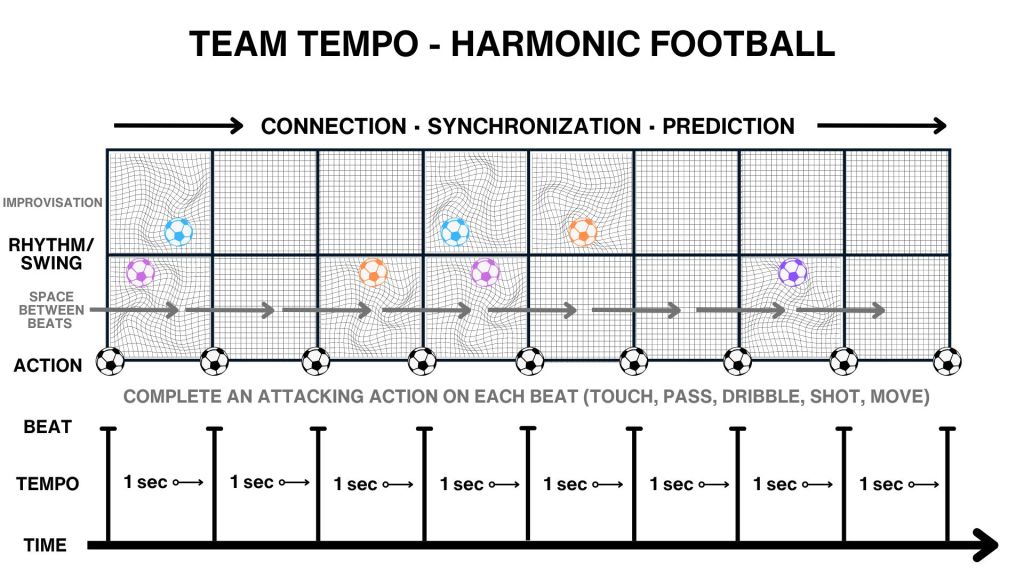
We understand the spatial elements of our sport deeply but spatial events are at the mercy of time. We play the game in a continuum and it is as much a game of when as it is where. Spatial dimensions are familiar to us. We understand width, depth and height. Formations, spacing and zones are coordinated according to these and are part of the game’s vocabulary but when describing temporal elements, we struggle to find reference points. Team tempo is a way to lock into an underlying structure based in time and provide a new tool for cohesion that taps into our evolutionary biology and neurochemistry. We can use it to play the game more musically and synchronise powerfully with those around us. It is not a secret key to winning, but it opens many doors of variation and will spawn new analytical tools, tactical diversity and further ways to learn, coach and watch the game we love. Nothing can guarantee victory but for this new trick, the result is not entirely the point.
Still, playing temporal football is not art for the sake it. Team tempo has a functional purpose. It keeps a team on time so that the ball can be progressed with ruthless efficiency. It regulates distances and timings between teammates and it provides another substructure to reorganise with.
“In music, though, one doesn’t make the end of the composition the point of the composition. If that were so, the best conductors would be those who played fastest; and there would be composers who only wrote finales. People [would] go to concerts only to hear one crashing chord—because that’s the end. We thought [that] life by analogy was a journey, was a pilgrimage, which had a serious purpose at the end. And the thing was to get to that end. Success, or whatever it is. But we missed the point the whole way along. It was a musical thing, and you were supposed to sing, or to dance, while the music was being played.” – Alan Watts
At Speers Point, the session begins. The Newcastle Jets youth team blast through a series of tailored exercises. Stoppages are rare and exact timing is critical. Real football scenarios are present at every step.
At Kingston Heath, the session begins. The Bentleigh Greens blast through a series of tailored exercises. Stoppages are rare and exact timing is critical. Real football scenarios are present at every step.
Two timelines converge and we feel an underlying beat to the sessions, it’s sound in the background flowing consistently along the arrow of time. Attacking actions are locked into the tick of the clock. Both sets of players trying their best to maintain team tempo and play on the beat. Improvisation is encouraged but that freedom lies within structure.